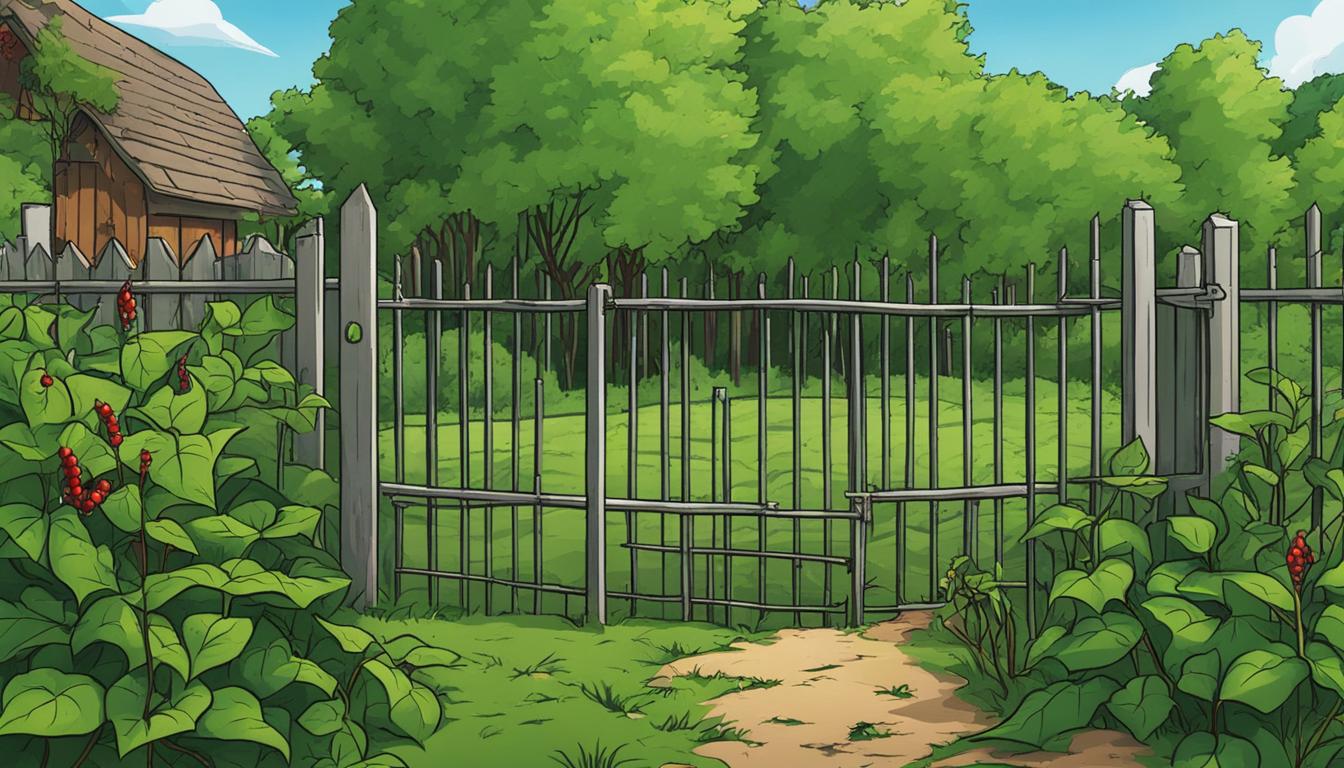When it comes to poison ivy eradication, timing is everything. Understanding the optimal time to get rid of poison ivy can make all the difference in effectively eliminating this pesky plant. Whether you’re dealing with a small vine or a larger shrub, knowing when to remove poison ivy can significantly increase your chances of success. In this article, we will explore the best time to kill poison ivy and provide you with effective methods to eliminate this irritating plant.
Key Takeaways:
- The highest oil content in poison ivy occurs during spring and summer.
- Sensitive individuals may develop a rash within 12 to 48 hours of contact.
- Washing with running water and using rubbing alcohol are recommended for oil removal.
- Chemical control with herbicides can be used to eradicate poison ivy.
- Timing is important for effective removal, with spring and early summer being optimal.
Identification and Characteristics of Poison Ivy
Poison ivy is a highly recognizable plant due to its distinct characteristics. It can be identified by its vine-like or shrub-like appearance and its ability to attach itself to trees or structures with hairy, aerial roots. The leaves of poison ivy are compound and occur in threes, with smooth, wavy, lobed, or toothed edges. Interestingly, these leaves can resemble oak leaves, which can make identification a bit tricky for the untrained eye.
Additionally, poison ivy produces clusters of white, waxy fruit that stand out against the plant’s green foliage. It is important to note that all parts of the poison ivy plant, including its leaves, stems, and roots, contain the toxic oil urushiol. Therefore, it is crucial to accurately identify poison ivy before attempting any control measures to avoid unwanted exposure and allergic reactions.
| Characteristics | Details |
|---|---|
| Leaf Appearance | Compound leaves occurring in threes with smooth, wavy, lobed, or toothed edges. |
| Leaf Resemblance | Leaves can resemble oak leaves, making identification challenging. |
| Attachment | Vine-like or shrub-like appearance with hairy, aerial roots used for attachment. |
| Fruit | Clusters of white, waxy fruit that stand out against the plant’s green foliage. |
| Poisonous Components | All parts of the plant, including leaves, stems, and roots, contain the toxic oil urushiol. |
By understanding the identification and characteristics of poison ivy, individuals can take the necessary precautions to avoid contact and effectively control its growth.
Risks and Allergies of Poison Ivy
While poison ivy can be a nuisance for many, some individuals are more sensitive to its effects than others. For these sensitive individuals, contact with poison ivy can lead to a severe skin rash within hours. The rash often appears as small, itchy bumps and can take up to two weeks to fully develop. It is important to note that sensitivity to poison ivy can change over time, meaning someone who was not affected before may develop a reaction later.
When it comes to dealing with poison ivy, it is crucial to take the necessary precautions to prevent exposure. Washing the affected area with cool water and soap is recommended within 10 minutes of contact to remove the rash-causing oil, known as urushiol. However, it is important to avoid using soaps that contain oils, as they can spread the oil and make the rash more widespread. Instead, using a washcloth and rubbing alcohol or specially prepared cleansing agents can effectively remove the oil from the skin.
To further protect yourself from poison ivy, it is advisable to wear protective clothing, such as long-sleeved shirts, long pants, and gloves, when removing or treating the plant. Additionally, it is crucial to wash any clothing, gloves, and tools that may have come into contact with the plant separately to prevent spreading the oil. It is worth noting that other plants, such as azaleas and wisteria, can also cause itchy rashes, so it is important to be cautious in outdoor environments.
Methods and Timing of Poison Ivy Removal
When it comes to removing poison ivy, there are several methods available. One option is to dig up small plants or repeatedly cut them back to ground level. This can help control the spread of the plant and prevent it from growing larger. Another effective method is chemical control, using herbicides that contain glyphosate, triclopyr, or a 3-way herbicide. These herbicides can be applied directly to the plant to eradicate it.
Timing is key when it comes to poison ivy removal. Cutting back the plant is best done in the spring, as this is when it is most actively growing. By cutting it back during this time, you can help prevent it from spreading and minimize its impact. Herbicide treatments, on the other hand, are most effective in late spring or early summer when the plant is actively growing and the leaves have fully expanded. Triclopyr offers the best control when applied at this stage, while glyphosate is effective when applied between 2 weeks before and 2 weeks after full bloom.
It is important to follow safety precautions when removing poison ivy. Wear protective clothing, such as long-sleeved shirts, long pants, and gloves, to minimize the risk of coming into contact with the plant’s oils. Additionally, be sure to wash any clothing or tools that may have come into contact with the plant separately to prevent spreading the oil. Taking these precautions can help ensure a safe and effective poison ivy removal process.
| Method | Timing |
|---|---|
| Cutting back | Spring |
| Herbicide treatments | Late spring or early summer |
Safety Precautions and Protective Measures
When it comes to dealing with poison ivy, taking safety precautions and protective measures is crucial to avoid exposure to the plant’s oils and prevent allergic reactions. Here are some key steps to keep in mind:
- Wear protective clothing: Whenever you’re removing or treating poison ivy, make sure to wear long-sleeved shirts, long pants, and gloves to minimize direct contact with the plant.
- Separate clothing and tools: After working with poison ivy, it’s important to wash your clothing and tools separately to prevent spreading the oil to other surfaces.
- Wash off the oil: If you come into contact with poison ivy, immediately wash the affected area with cool water and soap. Avoid using soap that contains oils, as this can spread the oil and make the rash more widespread.
- Use specialized cleansing agents: Products like Tecnu are specifically designed to remove poison ivy oils from clothes, gloves, tools, and the skin. These can be effective in preventing further exposure.
- Beware of other plants: Keep in mind that other plants, such as azaleas and wisteria, can also cause itchy rashes. Take care to identify and avoid contact with these plants as well.
By following these safety precautions and protective measures, you can minimize the risk of exposure to poison ivy and reduce the likelihood of developing a rash or other allergic reactions.
| Safety Tips | Precautions |
|---|---|
| Wear protective clothing | Long-sleeved shirts, long pants, and gloves |
| Separate clothing and tools | Wash separately to prevent oil spread |
| Wash off the oil | Cool water and soap, avoid oil-containing soaps |
| Use specialized cleansing agents | Products like Tecnu can remove poison ivy oils |
| Beware of other plants | Avoid contact with azaleas and wisteria |
Conclusion
In conclusion, the best time to kill poison ivy depends on the method used. It is crucial to remove or treat the plant when it is small to prevent it from spreading and becoming more challenging to eradicate. Cutting back poison ivy is most effective in the spring, while herbicide treatments yield optimal results in late spring or early summer, when the plant is actively growing.
Fall can also be a suitable time to address poison ivy, as the plant starts preparing for winter and stores carbohydrates. However, it is essential to take safety precautions and protective measures to avoid exposure to the plant’s oils and prevent allergic reactions. Wearing long-sleeved shirts, long pants, and gloves, and washing clothing and tools separately are all important preventive steps.
By following these guidelines and being proactive in poison ivy control, you can effectively manage this noxious plant and minimize the risks associated with it. Remember to wash off any oil from the skin within 10 minutes of exposure and use suitable cleansing agents to remove the rash-causing oil. With the right approach and timing, you can successfully eradicate poison ivy from your surroundings.
FAQ
What is poison ivy?
Poison ivy is a woody, perennial vine or small shrub that produces compound leaves that occur in threes and white fruit. The entire plant is poisonous due to the oil urushiol found in its leaves, stems, and roots.
How long does poison ivy oil remain active?
The oil urushiol in poison ivy can remain active for months on objects and can cause allergic reactions.
When is poison ivy most dangerous?
Poison ivy is most dangerous in spring and summer when its oil content is highest.
How long does it take for a rash to develop after contact?
Sensitive individuals may develop a rash within 12 to 48 hours of contact with poison ivy.
What should I do if I come into contact with poison ivy?
It is important to wash with running water and avoid using soaps that contain oils. Rubbing alcohol is a better solvent for the oil. There are also specially prepared cleansing agents available.
How can poison ivy be eradicated?
Poison ivy can be removed by digging up small plants or cutting them back to ground level. Chemical control and herbicides containing glyphosate, triclopyr, or a 3-way herbicide can also be used to eradicate poison ivy.
When is the best time to remove poison ivy?
Cutting back poison ivy is best done in the spring, while herbicide treatments are most effective in late spring or early summer.
What safety precautions should I take when removing poison ivy?
It is important to wear protective clothing such as long-sleeved shirts, long pants, and gloves. Clothing and tools should be washed separately to prevent spreading the oil. Products like Tecnu can help remove poison ivy oils from clothes, gloves, tools, and the skin.
Can other plants cause itchy rashes like poison ivy?
Yes, other plants such as azaleas and wisteria can also cause itchy rashes.
Can sensitivity to poison ivy change over time?
Yes, sensitivity to poison ivy can change over time, so someone who was not affected at one time may develop a reaction later.

![Ray Dalio Quotes [Principles, Life, Investment]](https://tagvault.org/wp-content/uploads/2023/04/Screen-Shot-2023-04-19-at-7.57.49-PM.png)
